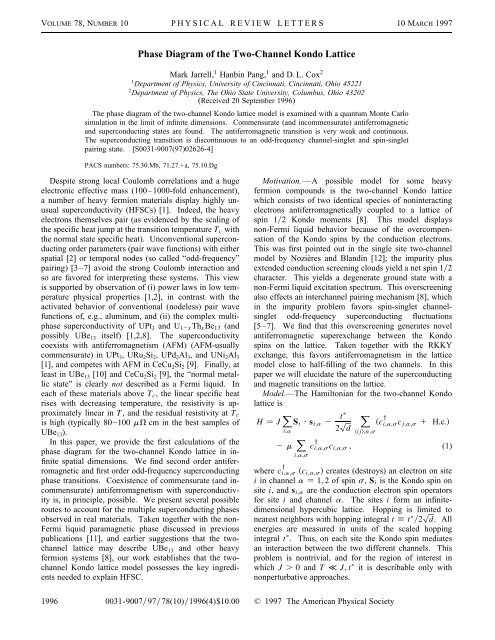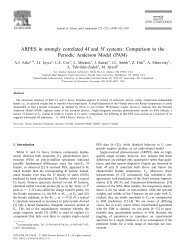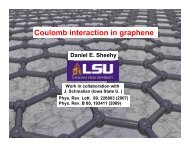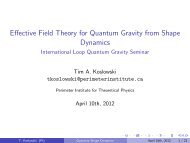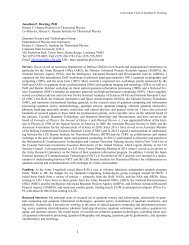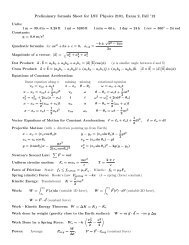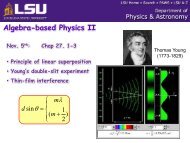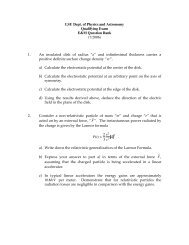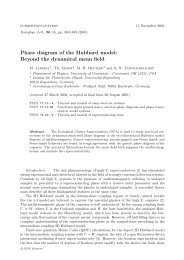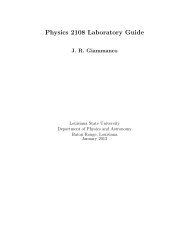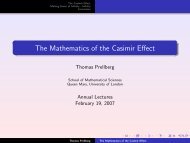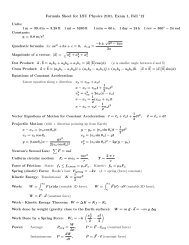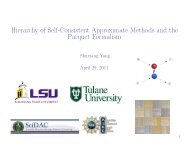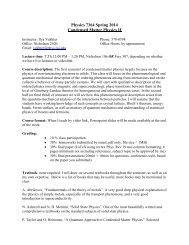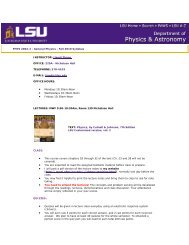Phase Diagram of the Two-Channel Kondo Lattice - APS Link ...
Phase Diagram of the Two-Channel Kondo Lattice - APS Link ...
Phase Diagram of the Two-Channel Kondo Lattice - APS Link ...
You also want an ePaper? Increase the reach of your titles
YUMPU automatically turns print PDFs into web optimized ePapers that Google loves.
VOLUME 78, NUMBER 10 PHYSICAL REVIEW LETTERS 10MARCH 1997<br />
<strong>Phase</strong> <strong>Diagram</strong> <strong>of</strong> <strong>the</strong> <strong>Two</strong>-<strong>Channel</strong> <strong>Kondo</strong> <strong>Lattice</strong><br />
Mark Jarrell, 1 Hanbin Pang, 1 and D. L. Cox 2<br />
1 Department <strong>of</strong> Physics, University <strong>of</strong> Cincinnati, Cincinnati, Ohio 45221<br />
2 Department <strong>of</strong> Physics, The Ohio State University, Columbus, Ohio 43202<br />
(Received 20 September 1996)<br />
The phase diagram <strong>of</strong> <strong>the</strong> two-channel <strong>Kondo</strong> lattice model is examined with a quantum Monte Carlo<br />
simulation in <strong>the</strong> limit <strong>of</strong> infinite dimensions. Commensurate (and incommensurate) antiferromagnetic<br />
and superconducting states are found. The antiferromagnetic transition is very weak and continuous.<br />
The superconducting transition is discontinuous to an odd-frequency channel-singlet and spin-singlet<br />
pairing state. [S0031-9007(97)02626-4]<br />
PACS numbers: 75.30.Mb, 71.27.+a, 75.10.Dg<br />
Despite strong local Coulomb correlations and a huge<br />
electronic effective mass (100–1000-fold enhancement),<br />
a number <strong>of</strong> heavy fermion materials display highly unusual<br />
superconductivity (HFSCs) [1]. Indeed, <strong>the</strong> heavy<br />
electrons <strong>the</strong>mselves pair (as evidenced by <strong>the</strong> scaling <strong>of</strong><br />
<strong>the</strong> specific heat jump at <strong>the</strong> transition temperature T c with<br />
<strong>the</strong> normal state specific heat). Unconventional superconducting<br />
order parameters (pair wave functions) with ei<strong>the</strong>r<br />
spatial [2] or temporal nodes (so called “odd-frequency”<br />
pairing) [3–7] avoid <strong>the</strong> strong Coulomb interaction and<br />
so are favored for interpreting <strong>the</strong>se systems. This view<br />
is supported by observation <strong>of</strong> (i) power laws in low temperature<br />
physical properties [1,2], in contrast with <strong>the</strong><br />
activated behavior <strong>of</strong> conventional (nodeless) pair wave<br />
functions <strong>of</strong>, e.g., aluminum, and (ii) <strong>the</strong> complex multiphase<br />
superconductivity <strong>of</strong> UPt 3 and U 12x Th x Be 13 (and<br />
possibly UBe 13 itself) [1,2,8]. The superconductivity<br />
coexists with antiferromagnetism (AFM) (AFM-usually<br />
commensurate) in UPt 3 , URu 2 Si 2 , UPd 2 Al 3 , and UNi 2 Al 3<br />
[1], and competes with AFM in CeCu 2 Si 2 [9]. Finally, at<br />
least in UBe 13 [10] and CeCu 2 Si 2 [9], <strong>the</strong> “normal metallic<br />
state” is clearly not described as a Fermi liquid. In<br />
each <strong>of</strong> <strong>the</strong>se materials above T c , <strong>the</strong> linear specific heat<br />
rises with decreasing temperature, <strong>the</strong> resistivity is approximately<br />
linear in T, and <strong>the</strong> residual resistivity at T c<br />
is high (typically 80 100 mV cm in <strong>the</strong> best samples <strong>of</strong><br />
UBe 13 ).<br />
In this paper, we provide <strong>the</strong> first calculations <strong>of</strong> <strong>the</strong><br />
phase diagram for <strong>the</strong> two-channel <strong>Kondo</strong> lattice in infinite<br />
spatial dimensions. We find second order antiferromagnetic<br />
and first order odd-frequency superconducting<br />
phase transitions. Coexistence <strong>of</strong> commensurate (and incommensurate)<br />
antiferromagnetism with superconductivity<br />
is, in principle, possible. We present several possible<br />
routes to account for <strong>the</strong> multiple superconducting phases<br />
observed in real materials. Taken toge<strong>the</strong>r with <strong>the</strong> non-<br />
Fermi liquid paramagnetic phase discussed in previous<br />
publications [11], and earlier suggestions that <strong>the</strong> twochannel<br />
lattice may describe UBe 13 and o<strong>the</strong>r heavy<br />
fermion systems [8], our work establishes that <strong>the</strong> twochannel<br />
<strong>Kondo</strong> lattice model possesses <strong>the</strong> key ingredients<br />
needed to explain HFSC.<br />
Motivation.—A possible model for some heavy<br />
fermion compounds is <strong>the</strong> two-channel <strong>Kondo</strong> lattice<br />
which consists <strong>of</strong> two identical species <strong>of</strong> noninteracting<br />
electrons antiferromagnetically coupled to a lattice <strong>of</strong><br />
spin 12 <strong>Kondo</strong> moments [8]. This model displays<br />
non-Fermi liquid behavior because <strong>of</strong> <strong>the</strong> overcompensation<br />
<strong>of</strong> <strong>the</strong> <strong>Kondo</strong> spins by <strong>the</strong> conduction electrons.<br />
This was first pointed out in <strong>the</strong> single site two-channel<br />
model by Nozières and Blandin [12]; <strong>the</strong> impurity plus<br />
extended conduction screening clouds yield a net spin 12<br />
character. This yields a degenerate ground state with a<br />
non-Fermi liquid excitation spectrum. This overscreening<br />
also effects an interchannel pairing mechanism [8], which<br />
in <strong>the</strong> impurity problem favors spin-singlet channelsinglet<br />
odd-frequency superconducting fluctuations<br />
[5–7]. We find that this overscreening generates novel<br />
antiferromagnetic superexchange between <strong>the</strong> <strong>Kondo</strong><br />
spins on <strong>the</strong> lattice. Taken toge<strong>the</strong>r with <strong>the</strong> RKKY<br />
exchange, this favors antiferromagnetism in <strong>the</strong> lattice<br />
model close to half-filling <strong>of</strong> <strong>the</strong> two channels. In this<br />
paper we will elucidate <strong>the</strong> nature <strong>of</strong> <strong>the</strong> superconducting<br />
and magnetic transitions on <strong>the</strong> lattice.<br />
Model.—The Hamiltonian for <strong>the</strong> two-channel <strong>Kondo</strong><br />
lattice is<br />
H J X S i ? s i,a 2<br />
t<br />
i,a<br />
2 p X<br />
ci,a,sc y j,a,s 1 H.c.<br />
d<br />
ij,a,s<br />
2m X<br />
ci,a,sc y i,a,s , (1)<br />
i,a,s<br />
where c y i,a,s c i,a,s creates (destroys) an electron on site<br />
i in channel a 1, 2 <strong>of</strong> spin s, S i is <strong>the</strong> <strong>Kondo</strong> spin on<br />
site i, and s i,a are <strong>the</strong> conduction electron spin operators<br />
for site i and channel a. The sites i form an infinitedimensional<br />
hypercubic lattice. Hopping is limited to<br />
nearest neighbors with hopping integral t t 2 p d. All<br />
energies are measured in units <strong>of</strong> <strong>the</strong> scaled hopping<br />
integral t . Thus, on each site <strong>the</strong> <strong>Kondo</strong> spin mediates<br />
an interaction between <strong>the</strong> two different channels. This<br />
problem is nontrivial, and for <strong>the</strong> region <strong>of</strong> interest in<br />
which J . 0 and T ø J, t it is describable only with<br />
nonperturbative approaches.<br />
1996 0031-90079778(10)1996(4)$10.00 © 1997 The American Physical Society
VOLUME 78, NUMBER 10 PHYSICAL REVIEW LETTERS 10MARCH 1997<br />
Formalism and Simulation.—Metzner and Vollhardt<br />
[13] provided a simplified method for solving such problems<br />
in a nontrivial limit. They observed that <strong>the</strong> renormalizations<br />
due to local two-particle interactions become<br />
purely local for <strong>the</strong> coordination number tending to infinity.<br />
In consequence, most standard lattice models may be<br />
mapped onto <strong>the</strong> solution <strong>of</strong> an effective correlated impurity<br />
coupled to a self-consistently determined bath or<br />
medium (see [14] for fur<strong>the</strong>r details and references).<br />
We solve <strong>the</strong> effective impurity problem for Eq. (1)<br />
by using <strong>the</strong> quantum Monte Carlo (QMC) algorithm <strong>of</strong><br />
Fye and Hirsch [15], modified for <strong>the</strong> two-channel <strong>Kondo</strong><br />
model [16]. We simulated <strong>the</strong> model for several fillings<br />
N 0 , N # 1 and exchange interaction strengths J<br />
J 0.75, 0.625, 0.5, 0.4. Error bars on <strong>the</strong> measured<br />
quantities are less than 6% for <strong>the</strong> results presented<br />
here. A sign problem encountered in <strong>the</strong> QMC process<br />
prevented us from studying J $ 0.8 and N # 0.5 since<br />
lower temperatures are required to access <strong>the</strong> physically<br />
interesting regime.<br />
The QMC simulation naturally produces both one- and<br />
two-particle properties. The local spin susceptibility x L<br />
was obtained by measuring <strong>the</strong> three-by-three matrix <strong>of</strong><br />
<strong>the</strong> local susceptibility, including both <strong>the</strong> <strong>Kondo</strong> spin and<br />
conduction band spin fluctuations. x was <strong>the</strong>n inverted to<br />
calculate <strong>the</strong> associated irreducible vertex function and <strong>the</strong><br />
corresponding lattice susceptibility in <strong>the</strong> usual way [17].<br />
The situation for <strong>the</strong> superconductivity is more complicated.<br />
Only <strong>the</strong> two conduction channels contribute<br />
to <strong>the</strong> pair-field susceptibility. We can <strong>the</strong>n look<br />
for pairing instabilities in singlet and triplet channels<br />
for both spin and channel. Motivated by impurity<br />
model results [5,6], we have restricted our attention to<br />
<strong>the</strong> particle-particle propagator diagrams as shown in<br />
Fig. 1. It is possible to make two independent combinations<br />
<strong>of</strong> <strong>the</strong>se diagrams, viz., x 6 iv n , iv m , q <br />
x 11 iv n , iv m , q 6x 12 iv n , iv m , q, from which we<br />
construct a quartet <strong>of</strong> spin and channel, singlet and triplet<br />
pair-field susceptibilities given by<br />
P SsCs q, T T X nm<br />
f 2 iv n x 2 iv n , iv m , qf 2 iv m ,<br />
(2)<br />
P StCt q, T T X f 1 iv n x 1 iv n , iv m , qf 1 iv m ,<br />
nm<br />
(3)<br />
FIG. 1. Particle-particle interchannel opposite spin diagrams<br />
which contribute to <strong>the</strong> pair-field susceptibility. Here 1 and 2<br />
label <strong>the</strong> channel, and " and # <strong>the</strong> spin. Summing over k and k 0<br />
yields x 11 and x 12 .<br />
P StCs q, T T X nm<br />
x 2 iv n , iv m , q , (4)<br />
P SsCt q, T T X nm<br />
x 1 iv n , iv m , q . (5)<br />
Here f 6 iv n are odd functions <strong>of</strong> Matsubara frequency<br />
used to project out <strong>the</strong> odd-frequency pairing, and, for<br />
example, P SsCs q, T is <strong>the</strong> spin-singlet channel-singlet<br />
pair-field susceptibility for a pair with center-<strong>of</strong>-mass<br />
momentum q.<br />
To determine <strong>the</strong> form <strong>of</strong> f 6 iv n , we have employed<br />
<strong>the</strong> pairing matrix formalism <strong>of</strong> Owen and Scalapino [18].<br />
We have represented each x 6 in a two-particle Dyson<br />
equation and extracted <strong>the</strong> irreducible vertex functions<br />
G 6 . The resulting pairing matrices are<br />
q<br />
M 6 iv n , iv m , q x6iv 0 n , q G 6 iv n , iv m <br />
3<br />
q<br />
x 0 6iv m , q , (6)<br />
where x6 0 iv n, q are <strong>the</strong> particle-particle diagrams in<br />
Fig. 1 without vertex corrections. f 6 iv n is <strong>the</strong> eigenvector<br />
corresponding to <strong>the</strong> dominant eigenvalue <strong>of</strong> M 6<br />
(that with <strong>the</strong> largest absolute value).<br />
Results.—In this model, antiferromagnetism is driven<br />
by both RKKY interactions and a novel type <strong>of</strong> superexchange.<br />
The latter arises from hopping between adjacent<br />
spin 12 screening clouds, whose overall spin is determined<br />
by <strong>the</strong> conduction electrons; <strong>the</strong> Pauli principle forbids<br />
hopping unless neighboring spins in <strong>the</strong> same channel<br />
are antiparallel. As a result, for large J, <strong>the</strong> superexchange<br />
goes as t 2 J. For conduction band fillings<br />
close to N 1, both <strong>the</strong> RKKY (evaluated at nearest<br />
neighbor sites) and <strong>the</strong> superexchange favor antiferromagnetism<br />
(<strong>the</strong> RKKY exchange remains antiferromagnetic<br />
until N & 0.5), and an antiferromagnetic transition results,<br />
as shown in Fig. 2. Because <strong>of</strong> <strong>the</strong> screening <strong>of</strong> <strong>the</strong> local<br />
moments by <strong>the</strong> conduction spin, <strong>the</strong> transition is very<br />
weak, as measured by <strong>the</strong> full susceptibility. Specifically,<br />
x AF is not significantly enhanced over <strong>the</strong> bulk susceptibility<br />
x F until T * T N . However, <strong>the</strong> f-electron contribution<br />
to <strong>the</strong> susceptibility shows a protracted scaling region.<br />
Note that screening affects nonlinear feedback which reduces<br />
<strong>the</strong> susceptibility exponent g from <strong>the</strong> mean-field<br />
value g 1. g increases with doping N , 1, and <strong>the</strong><br />
transition becomes incommensurate as T N ! 0.<br />
To explore superconductivity, it is necessary to find <strong>the</strong><br />
frequency form factors f 6 discussed previously. As <strong>the</strong><br />
temperature is lowered, <strong>the</strong> dominant eigenvalue first becomes<br />
large (divergent) and negative, and <strong>the</strong>n abruptly<br />
switches to a large and positive value at <strong>the</strong> transition.<br />
This happens first in M 2 , and <strong>the</strong> corresponding eigenvector<br />
<strong>of</strong> M 2 is plotted in <strong>the</strong> inset to Fig. 3. It can<br />
be fit quite accurately to <strong>the</strong> form T2v n as shown by<br />
<strong>the</strong> solid line, which corresponds to <strong>the</strong> form factor <strong>of</strong><br />
Ref. [4]. Thus, we use f 2 iv n T2v n to project<br />
out <strong>the</strong> odd-frequency pair-field susceptibilities shown in<br />
1997
VOLUME 78, NUMBER 10 PHYSICAL REVIEW LETTERS 10MARCH 1997<br />
FIG. 2. Antiferromagnetic x AF and ferromagnetic x F susceptibilities<br />
<strong>of</strong> <strong>the</strong> two-channel <strong>Kondo</strong> lattice with J 0.75 and<br />
N 1.0. Inset: <strong>the</strong> local moment contribution to <strong>the</strong> susceptibility<br />
xAFT, f which displays a protracted scaling region well<br />
fit by 1xAFT f aT2T N g . Strong conduction screening<br />
<strong>of</strong> local moments is indicated by (i) x AF fixAFT f and<br />
(ii) g,1.<br />
Figs. 3 and 4. [O<strong>the</strong>r form factors fiv n tanhT 0 v n <br />
and sgnv n produce qualitatively similar results.]<br />
The first transition is found in <strong>the</strong> spin-singlet channelsinglet<br />
pairing combination, as shown in Fig. 3. (Note<br />
that this pair state is even in parity, so that <strong>the</strong> oddfrequency<br />
condition enforces <strong>the</strong> Pauli principle, in contrast<br />
with <strong>the</strong> odd-parity and odd-frequency spin-singlet<br />
pairs <strong>of</strong> <strong>the</strong> single-channel case [3,4].) To interpret this<br />
result, remember that <strong>the</strong> inverse pair-field susceptibility is<br />
proportional to <strong>the</strong> curvature <strong>of</strong> <strong>the</strong> free energy fD SsCs <br />
as a function <strong>of</strong> <strong>the</strong> pairing order parameter 1P SsCs ~<br />
d 2 fD SsCs dD 2 SsCs. Thus, if P SsCs , 0 a <strong>the</strong>rmodynamic<br />
instability <strong>of</strong> <strong>the</strong> system is present. The associated transition<br />
cannot be continuous, since this requires <strong>the</strong> free energy<br />
in order parameter space to become flat (i.e., P SsCs<br />
diverges) so that <strong>the</strong> order parameter may change continuously.<br />
Thus, we identify this as a discontinuous transition.<br />
Fur<strong>the</strong>rmore, if P SsCs T 0, <strong>the</strong>n T is a lower bound<br />
to <strong>the</strong> transition temperature since, when P SsCs T 2 T <br />
0 2 0 2 , <strong>the</strong> curvature <strong>of</strong> fD SsCs is divergent and negative;<br />
i.e., <strong>the</strong> free energy displays a downward cusp which<br />
would compel <strong>the</strong> order parameter and <strong>the</strong> free energy to<br />
change discontinuously at T , which involves an infinite<br />
energy at <strong>the</strong> transition. Hence, <strong>the</strong> actual transition occurs<br />
at a temperature T c . T .<br />
Several remarks are in order about this unusual superconductivity:<br />
(a) Figure 3 suggests that <strong>the</strong> transition is<br />
degenerate at <strong>the</strong> zone center and <strong>the</strong> zone corner, and, in<br />
fact, P SsCs vanishes simultaneously over <strong>the</strong> whole zone,<br />
and hence this is a locally driven transition. This degeneracy<br />
will be lifted in finite dimensionality as <strong>the</strong> superfluid<br />
stiffness Y s (analogous to spin stiffness in a magnet) must<br />
vanish in infinite d. For finite d with Y s q 0 . 0<br />
, 0, a local free energy minimum will be found at<br />
q 0 q fi 0. (b) The vanishing <strong>of</strong> <strong>the</strong> local pair susceptibility<br />
here at T contrasts with <strong>the</strong> impurity model<br />
in which it diverges logarithmically as T ! 0 [5,6]. (c)<br />
The excitation spectrum <strong>of</strong> such a transition may well be<br />
highly exotic [4].<br />
As shown in Fig. 4, <strong>the</strong> ground state <strong>of</strong> <strong>the</strong> system may<br />
be superconducting or magnetic, which may coexist or<br />
compete. Detailed exploration within <strong>the</strong> ordered phases<br />
will answer this question definitively, as <strong>the</strong> present work<br />
only indicates <strong>the</strong> presence <strong>of</strong> transitions. In general superconductivity<br />
will occur first (at <strong>the</strong> highest transition<br />
temperature) away from half-filling, and antiferromagnetism<br />
will occur first near half-filling. However, for values<br />
<strong>of</strong> J . 0.75, we found that superconductivity occurs<br />
FIG. 3. Odd-frequency (spin-singlet, channel-singlet) pairfield<br />
susceptibility. At T T 0.041 # T c , P SsCs T<br />
becomes negative for both zone-center and zone-corner pairs,<br />
indicating a discontinuous transition to a paired state. Inset:<br />
<strong>the</strong> dominant zone-center eigenvector [or form factor f 2<br />
<strong>of</strong> Eqs. (2)–(5)] <strong>of</strong> <strong>the</strong> pairing matrix M 2 vs Matsubara<br />
frequency; f 2 0.5Tv n as in Ref. [4].<br />
1998<br />
FIG. 4. <strong>Phase</strong> diagrams <strong>of</strong> <strong>the</strong> two-channel <strong>Kondo</strong> lattice for<br />
various values <strong>of</strong> J. The solid lines are fits to <strong>the</strong> data.<br />
The antiferromagnetic transition becomes incommensurate near<br />
T N ! 0. The temperature T CT 0 is a lower bound to <strong>the</strong><br />
first order superconducting transition temperature (cf., Fig. 3);<br />
here C 0.43J 0.5, 0.51J 0.625, 0.58J 0.75.
VOLUME 78, NUMBER 10 PHYSICAL REVIEW LETTERS 10MARCH 1997<br />
first even at half-filling (<strong>the</strong> minus sign problem precluded<br />
a systematic study for <strong>the</strong>se values <strong>of</strong> J so <strong>the</strong>y are not<br />
presented in Fig. 4). We also found that T CJT 0 ,<br />
with CJ 0.5 and weakly dependent on J. In contrast,<br />
T N appears to depend upon both J and T 0 .<br />
Speculation and Interpretation.—We <strong>of</strong>fer two compatible<br />
interpretations <strong>of</strong> <strong>the</strong> result T 0.5T 0 . First, T 0 is<br />
<strong>the</strong> local dynamic energy scale, and thus this result underscores<br />
<strong>the</strong> local origin <strong>of</strong> <strong>the</strong> pairing. Second, T 0.5T 0<br />
is also <strong>the</strong> temperature at which <strong>the</strong> slope <strong>of</strong> <strong>the</strong> real part<br />
<strong>of</strong> <strong>the</strong> self-energy becomes one [11], so that <strong>the</strong> quasiparticle<br />
renormalization factor diverges. This result suggests<br />
that, when <strong>the</strong> system cannot form a Fermi liquid due to<br />
a large residual scattering rate (with concomitant residual<br />
entropy), it forms a superconducting state to quench <strong>the</strong><br />
entropy. The antiferromagnetic transition temperature, on<br />
<strong>the</strong> o<strong>the</strong>r hand, depends upon both J (through <strong>the</strong> intersite<br />
exchange) and T 0 (through moment screening and superexchange).<br />
As noted above, we cannot determine whe<strong>the</strong>r<br />
<strong>the</strong>se states coexist without a detailed exploration within<br />
<strong>the</strong> ordered phases. At half-filling, where <strong>the</strong> antiferromagnetism<br />
produces an insulating phase, clearly <strong>the</strong> superconductivity<br />
will be suppressed for J # 0.75.<br />
Our results <strong>of</strong>fer a number <strong>of</strong> routes to be explored for<br />
explaining <strong>the</strong> complex superconducting phase diagrams<br />
<strong>of</strong> UPt 3 and U 12x Th x Be 13 : (1) Competition between<br />
phases with a multipoint irreducible star: As mentioned<br />
above, for Y s , 0 in finite d, q fi 0 pairs are favored,<br />
quite likely at <strong>the</strong> Brillouin zone corner for such a bipartite<br />
lattice. For lattices with frustration, such as hexagonal<br />
UPt 3 and fcc UBe 13 , multipoint irreducible stars may<br />
be needed to describe staggered order parameters which<br />
can <strong>the</strong>n have multiple phases [19]. (2) Competition between<br />
different q values: As noted above, T , <strong>the</strong> lower<br />
bound for <strong>the</strong> first order superconducting transition temperature,<br />
is independent <strong>of</strong> q in our calculations. Thus<br />
multiple phases may thus correspond to superconducting<br />
transitions with different q values. (3) Possible instability<br />
<strong>of</strong> spin-tripletchannel-triplet pairing: At yet lower temperatures<br />
than those identified in Fig. 4, we observe a sign<br />
change in <strong>the</strong> pair-field susceptibility associated with spin<br />
triplet-channel triplet odd-frequency pairing. Hence it is<br />
possible that <strong>the</strong> competition between this triplet-triplet<br />
and <strong>the</strong> singlet-singlet odd-frequency pairing may explain<br />
<strong>the</strong> complex phase diagrams.<br />
In conclusion, we note that this superconducting transition<br />
can agree with experiment only if it is weakly first<br />
order; this is plausible given <strong>the</strong> rapid change in free energy<br />
curvature at <strong>the</strong> order parameter origin. Detailed investigations<br />
in <strong>the</strong> ordered phase will resolve this issue,<br />
and whe<strong>the</strong>r any <strong>of</strong> <strong>the</strong> above scenarios can describe <strong>the</strong><br />
complex phase diagrams <strong>of</strong> UPt 3 and U 12x Th x Be 13 .<br />
We would like to acknowledge useful discussions<br />
with F. Anders, A. V. Balatsky, W. Chung, A. Georges,<br />
B. Goodman, D. Hess, H. R. Krishna-murthy, M. Ma, A. J.<br />
Millis, and W. Putikka. M. J. and H. P. would like to acknowledge<br />
<strong>the</strong> support <strong>of</strong> NSF Grants No. DMR-9406678<br />
and No. DMR-9357199. D. L. C. acknowledges <strong>the</strong> support<br />
<strong>of</strong> <strong>the</strong> NSF under Grant No. DMR-9420920. Computer<br />
support was provided by <strong>the</strong> Ohio Supercomputer<br />
Center.<br />
[1] Some good recent reviews are <strong>the</strong> following: N. Grewe<br />
and F. Steglich, Handbook on <strong>the</strong> Physics and Chemistry<br />
<strong>of</strong> Rare Earths, edited by K. A. Gschneidner, Jr.,<br />
and L. L. Eyring (Elsevier, Amsterdam, 1991), Vol. 14,<br />
p. 343; D. W. Hess, P. S. Riseborough, and J. L. Smith,<br />
Encyclopedia <strong>of</strong> Applied Physics, edited by G. L. Trigg<br />
(VCH Publishers Inc., New York, 1993), Vol. 7, p. 435;<br />
H. R. Ott, J. Low Temp. Phys. 95, 95 (1994).<br />
[2] J. A. Sauls, Adv. Phys. 43, 113–141 (1994).<br />
[3] V. L. Berezinski, JETP Lett. 20, 287 (1974); A. V.<br />
Balatsky and E. Abrahams, Phys. Rev. B 45, 13 125<br />
(1992); E. Abrahams et al., Phys. Rev. B 52, 1271 (1995).<br />
[4] P. Coleman, E. Miranda, and A. Tsvelik, Phys. Rev. Lett.<br />
70, 2960 (1993); P. Coleman, E. Miranda, and A. M.<br />
Tsvelik, Phys. Rev. B 49, 8955 (1994).<br />
[5] V. J. Emery and S. Kivelson, Phys. Rev. B 46, 10 812<br />
(1992).<br />
[6] A. W. W. Ludwig and I. Affleck, Nucl. Phys. B428, 545<br />
(1994).<br />
[7] Enhanced staggered odd-frequency pairing correlations<br />
exist in <strong>the</strong> one-dimensional <strong>Kondo</strong> lattice when left and<br />
right movers approximately decouple, rendering effectively<br />
a two-channel lattice; see O. Zachar, S. Kivelson,<br />
and V. Emery, Phys. Rev. Lett. 77, 1342 (1996).<br />
[8] D. L. Cox, Phys. Rev. Lett. 59, 1240 (1987); D. L. Cox,<br />
Physica (Amsterdam) 153C-155C, 1642 (1988); D. L.<br />
Cox, Physica (Amsterdam) 186B-188B, 312 (1993); D. L.<br />
Cox and M. B. Maple, Phys. Today 48, 32 (1995); D. L.<br />
Cox and M. Jarrell (unpublished).<br />
[9] F. Steglich et al., Physica (Amsterdam) 223B-224B, 1<br />
(1996).<br />
[10] This was noted much earlier in H. R. Ott, Prog. Low<br />
Temp. Phys. 6, 215 (1987).<br />
[11] M. Jarrell, H.-B. Pang, D. L. Cox, and K.-H. Luk, Phys.<br />
Rev. Lett. 77, 1612 (1996); M. Jarrell, H.-B. Pang, and<br />
D. L. Cox (unpublished); F. Anders, M. Jarrell, and D. L.<br />
Cox (unpublished).<br />
[12] P. Nozières and A. Blandin, J. Phys. (Paris) 41, 193<br />
(1980).<br />
[13] W. Metzner and D. Vollhardt, Phys. Rev. Lett. 62, 324<br />
(1989); see also E. Müller-Hartmann, Z. Phys. B 74, 507<br />
(1989).<br />
[14] Th. Pruschke, M. Jarrell, and J. K. Freericks, Adv. Phys.<br />
42, 187 (1995); A. Georges, G. Kotliar, W. Krauth, and<br />
M. Rozenberg, Rev. Mod. Phys. 68, 13 (1996).<br />
[15] R. M. Fye and J. E. Hirsch, Phys. Rev. B 38, 433 (1988).<br />
[16] K.-H. Luk, Mark Jarrell, and D. L. Cox, Phys. Rev. B 50,<br />
15 864 (1994).<br />
[17] M. Jarrell, Phys. Rev. B 51, 7429 (1995).<br />
[18] C. Owen and D. J. Scalapino, Physica (Amsterdam) 55,<br />
691 (1971).<br />
[19] R. Heid, Ya. B. Bazaliy, V. Martisovits, and D. L. Cox,<br />
Phys. Rev. Lett. 74, 2571 (1995).<br />
1999


